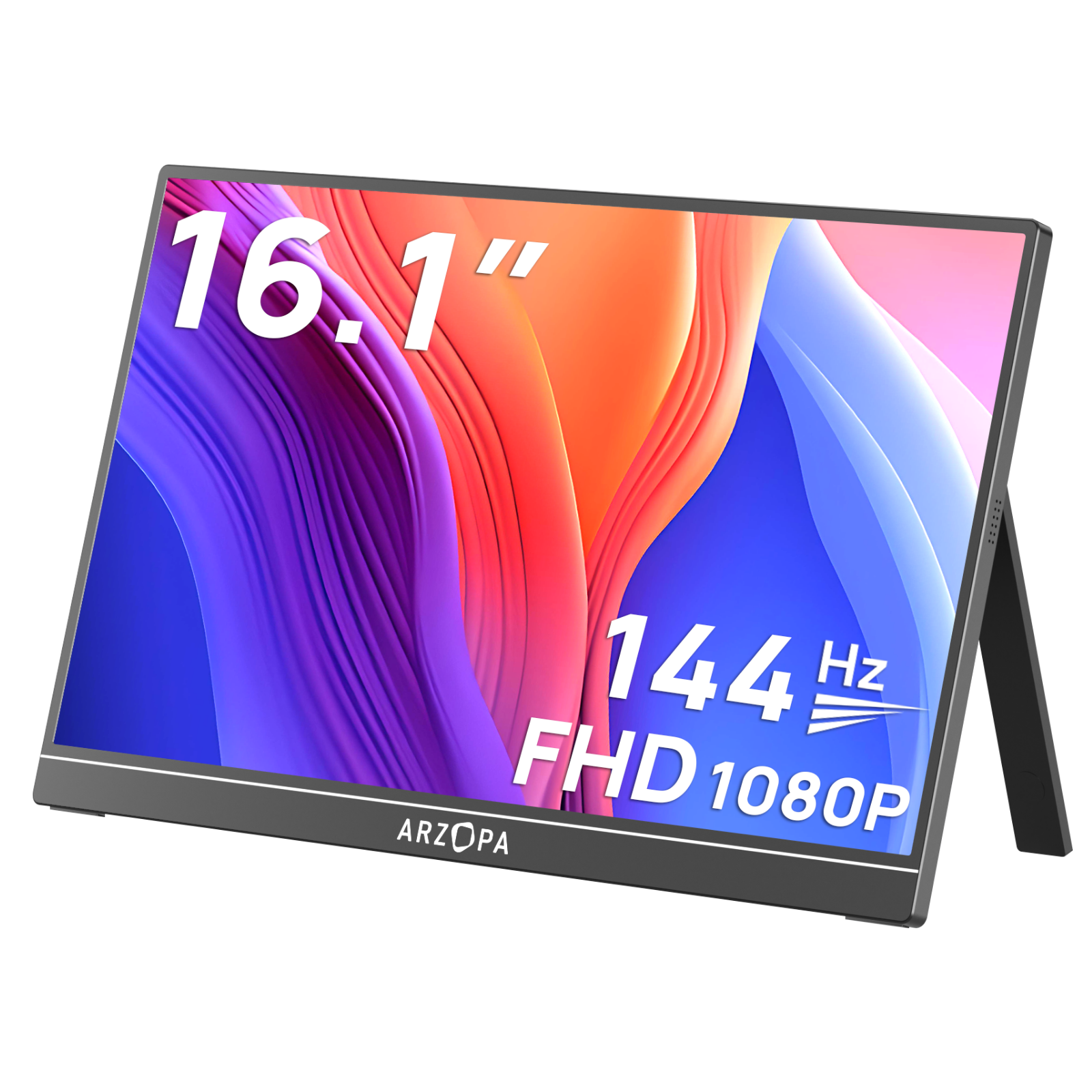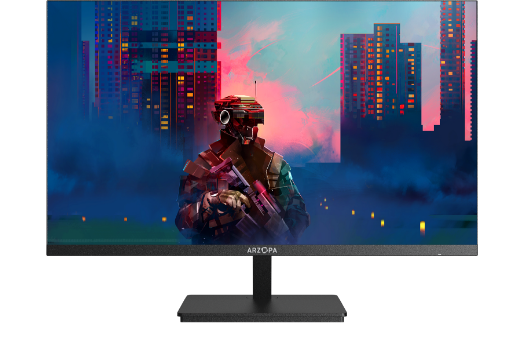What is the Difference Between 1080P and 2.5K Portable Monitors?
Whether you're working remotely, gaming on the go, or simply need a second screen for creative work, portable monitors are becoming essential tools. When choosing a portable monitor, resolution is a major decision point. Two common terms you’ll see are 1080P (Full HD) and 2.5K (also known as QHD+ or 2560 × 1600). So - what’s the real difference between 1080P and 2.5K portable monitors and which one should you choose?
What is 1080P Resolution? (Full HD)
-
Resolution: 1920 × 1080 pixels
-
Aspect Ratio: 16:9
-
Also Called: Full HD or FHD
-
Typical Use: Streaming, office work, video calls, basic gaming
1080P is the standard resolution for most screens. It offers a great balance of clarity, performance, and battery efficiency—ideal for everyday use.
What is 2.5K Resolution? (QHD+ or 2K+)
-
Resolution: 2560 × 1600 pixels
-
Aspect Ratio: 16:10
-
Also Called: 2.5K, WQXGA, or QHD+
-
Typical Use: Creative work, multitasking, detailed visuals, coding
2.5K resolution provides sharper details and more vertical space, thanks to its 16:10 aspect ratio. It's perfect for professionals who work with graphics, spreadsheets, or documents.
Resolution Basics: 1080P vs 2.5K
| Feature | 1080P (Full HD) | 2.5K (QHD+) |
|---|---|---|
| Resolution | 1920 × 1080 pixels | 2560 × 1600 pixels |
| Aspect Ratio | 16:9 | 16:10 |
| Pixel Density | Standard clarity | Sharper image, more detail |
| Ideal For | Everyday tasks, streaming | Creative work, document editing, detailed visuals |
| Power Consumption | Lower | Slightly higher |
| Price | More affordable | Typically more premium |
What are the Visual Differences Between 1080P and 2.5K?
If you're comparing portable monitors, especially for work, entertainment, or creative use, understanding the visual differences between 1080P and 2.5K resolution can help you make the right decision.
1. Image Sharpness and Detail
1080P (1920×1080) delivers clear visuals, but on larger screens or viewed up close, you may notice pixelation—especially around text and fine edges.
2.5K (2560×1600) provides significantly sharper visuals. Text appears crisper, images are more detailed, and icons are well-defined.
For users who work with documents, images, or videos, the increase in resolution offers a more refined viewing experience.
2. Text Clarity
1080P resolution is suitable for everyday tasks like browsing or email.
2.5K resolution makes a big difference when reading, coding, or editing—text appears smoother and easier on the eyes over long periods.
Professionals often prefer 2.5K for its improved readability and reduced eye strain.
3. Color Perception and Depth
While resolution doesn't directly affect color accuracy, a higher pixel density allows colors and gradients to appear smoother and more precise.
Displays like the Arzopa M1RC not only offer 2.5K resolution but also come with wide color gamut support, enhancing the visual experience further.
4. Screen Real Estate
1080P offers a standard workspace, but you may need to scroll more or switch windows frequently.
2.5K gives you more usable screen space, making it ideal for multitasking, large spreadsheets, and side-by-side document editing.
With more pixels, you can fit more content on the screen without sacrificing readability.
5. Pixel Density (PPI)
On a typical 15.6" screen:
1080P provides around 141 pixels per inch (PPI)
2.5K offers about 188 PPI
Higher pixel density results in smoother curves, sharper fonts, and a more professional appearance overall.
What are the Differences Between 1080P and 2.5K in Application?
| Use Case | 1080P (FHD) | 2.5K (QHD+) |
|---|---|---|
| Office Work | ✅ | ✅ |
| Graphic Design | ⚠️ (acceptable) | ✅ (recommended) |
| Video Editing | ✅ | ✅ |
| Web Browsing | ✅ | ✅ |
| Coding & Docs | ✅ | ✅ (more vertical space) |
| Gaming | ✅ | ✅ (if refresh rate is high) |
How to Choose Between 1080P and 2.5K?
If you need a reliable, lightweight monitor for everyday use or travel, and prefer better battery efficiency, choose 1080P monitor.
But If you want extra clarity, multitask with split-screen setups, or work with text, visuals, and spreadsheets in detail, choose 2.5K display
-
1080P monitors are perfect for most daily tasks: browsing, typing, attending meetings, or watching videos. They are lightweight, energy-efficient, and wallet-friendly.
-
2.5K monitors offer more screen real estate and sharper visuals, making them better for photo editing, document-heavy multitasking, or anyone who wants crisper text and images. The 16:10 aspect ratio provides more vertical space—a favourite among coders, writers, and designers.
Best 1080P and 2.5K Portable Monitor Recommendation
Whether you're editing photos, working remotely, or just watching Netflix on a second screen, your portable monitor's resolution can make a huge difference. Here's a quick comparison of Arzopa's most popular models by resolution, use case and feature.
| Model | Resolution | Size | Key Features | Best For | Price (approx.) |
|---|---|---|---|---|---|
| Arzopa Z1FC | 1920×1080P | 16.1" | 144Hz, USB-C/HDMI support | Daily use, travel, gaming Steam Deck gaming | |
| Arzopa Z1RC | 2560x1600P (2.5K) |
16.0" | 100% sRGB color, 16:10 ratio, lightweight, matte display | Streaming, casual design work | |
| Arzopa Z1C | 1920×1080P | 16.1" | 72% NTSC,16:9 ratio | Support PS5, Xbox, Switch, Steam Deck, PCs, phone, and more |
For Those Seeking a Sharper, More Immersive Portable Display
The Arzopa Z1RC is an excellent choice for users looking for vibrant visuals without jumping into full 4K. With its 2.5K resolution and 100% sRGB color, it offers crisp details and a more vertical workspace thanks to its 16:10 aspect ratio. It's lightweight, plug-and-play, and perfect for digital nomads or creators on the go.
Key Features of the Arzopa Z1RC Portable Monitor:
-
2.5K (2560×1600) QHD+ Resolution
-
16:10 Aspect Ratio for Extra Workspace
-
100% sRGB Color Coverage
-
Matte Display for Fewer Reflections
-
Lightweight & Travel-Friendly Design
Conclusion
Whether you choose a 1080P or a 2.5K portable monitor comes down to how you plan to use it. A 1080P display, like the Arzopa A1S or Z1FC is ideal for everyday tasks. It’s light, efficient, and budget-friendly—perfect for students, remote workers, or travelers who need reliable performance without extra cost. On the other hand, if your workflow involves creative tasks like photo editing, design, or multitasking across documents, the higher resolution and expanded screen space of a 2.5K monitor can offer a noticeably sharper and more comfortable viewing experience.

























